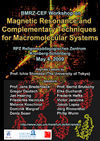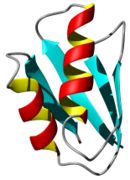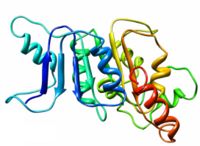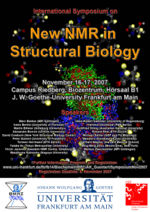News
(→2009) |
|||
| Line 4: | Line 4: | ||
== 2009 == | == 2009 == | ||
| + | |||
| + | === BMRZ Seminar by Prof. Vladislav Orekhov === | ||
| + | |||
| + | 10.12.2009 | ||
| + | |||
| + | Speaker: Prof. Vladislav Orekhov<br> | ||
| + | Affiliation: Swedish NMR Centre, University of Gothenburg, Sweden<br> | ||
| + | Lecture date and time: December 10, 2010, 16:00<br> | ||
| + | Lecture room: Biocenter Lecture hall N200 B2<br> | ||
| + | |||
| + | '''Structure determination of the human membrane protein VDAC-1:Co-processing NMR spectra with multi-dimensional decomposition''' | ||
| + | |||
| + | ''Prof. Vladislav Orekhov, Swedish NMR Centre, University of Gothenburg, Sweden'' | ||
| + | |||
| + | The analysis of typical sets of multidimensional NMR experiments for signal assignment, structure calculations, and metabolomic studies relies on matching of signal frequencies between several experiments. By simultaneous processing of the spectra, this intrinsic reoccurrence of signal frequencies and line-shapes is exploited to enhance the quality and efficiency of the data analysis. We use multi-dimensional decomposition (MDD) for co-processing of any combination of experiments and non-uniform sampling for optimizing spectra resolution and sensitivity. The approach has been successfully demonstrated for several essentially different situations: processing of 4D NOESY spectra for the de novo structure determination of the 31 kDa integral human membrane protein VDAC-1 in detergent micelles with an effective molecular weight of 70–90 kDa; rapid real-time data collection and automated backbone assignments of a 13 kDa naturally disordered cytoplasmic part of the zeta-chain of the T-cell receptor system; a metabolomic study on food-deprived fish. | ||
| + | |||
| + | * Hiller, S., Garces, R.G., Malia, T.J., Orekhov, V.Y., Colombini, M. & Wagner, G. Solution structure of the integral human membrane protein VDAC-1 in detergent micelles [http://dx.doi.org/10.1126/science.1161302 Science 321, 1206-1210 (2008)] | ||
| + | * Jaravine, V.A. and Orekhov, V.Y. Targeted acquisition for real-time NMR spectroscopy [http://dx.doi.org/10.1021/ja062146p J. Am. Chem. Soc. 128, 13421-13426 (2006)] | ||
| + | |||
=== Job announcement === | === Job announcement === | ||
| Line 72: | Line 91: | ||
* Wasmer, C. Lange, A., Van Melckebeke, H., Siemer, A. B., Riek, R. & Meier, B. H. (2008). Amyloid fibrils of the HET-s(218–289) prion form a β solenoid with a triangular hydrophobic core. Science 319, 1523–1526. | * Wasmer, C. Lange, A., Van Melckebeke, H., Siemer, A. B., Riek, R. & Meier, B. H. (2008). Amyloid fibrils of the HET-s(218–289) prion form a β solenoid with a triangular hydrophobic core. Science 319, 1523–1526. | ||
| − | |||
== 2008 == | == 2008 == | ||
Revision as of 15:11, 3 December 2009
2009
BMRZ Seminar by Prof. Vladislav Orekhov
10.12.2009
Speaker: Prof. Vladislav Orekhov
Affiliation: Swedish NMR Centre, University of Gothenburg, Sweden
Lecture date and time: December 10, 2010, 16:00
Lecture room: Biocenter Lecture hall N200 B2
Structure determination of the human membrane protein VDAC-1:Co-processing NMR spectra with multi-dimensional decomposition
Prof. Vladislav Orekhov, Swedish NMR Centre, University of Gothenburg, Sweden
The analysis of typical sets of multidimensional NMR experiments for signal assignment, structure calculations, and metabolomic studies relies on matching of signal frequencies between several experiments. By simultaneous processing of the spectra, this intrinsic reoccurrence of signal frequencies and line-shapes is exploited to enhance the quality and efficiency of the data analysis. We use multi-dimensional decomposition (MDD) for co-processing of any combination of experiments and non-uniform sampling for optimizing spectra resolution and sensitivity. The approach has been successfully demonstrated for several essentially different situations: processing of 4D NOESY spectra for the de novo structure determination of the 31 kDa integral human membrane protein VDAC-1 in detergent micelles with an effective molecular weight of 70–90 kDa; rapid real-time data collection and automated backbone assignments of a 13 kDa naturally disordered cytoplasmic part of the zeta-chain of the T-cell receptor system; a metabolomic study on food-deprived fish.
- Hiller, S., Garces, R.G., Malia, T.J., Orekhov, V.Y., Colombini, M. & Wagner, G. Solution structure of the integral human membrane protein VDAC-1 in detergent micelles Science 321, 1206-1210 (2008)
- Jaravine, V.A. and Orekhov, V.Y. Targeted acquisition for real-time NMR spectroscopy J. Am. Chem. Soc. 128, 13421-13426 (2006)
Job announcement
22.6.2009
Ph.D. and postdoctoral positions in "Hyper-dimensional NMR spectroscopy for automated protein structure determination"
BMRZ-CEF Workshop 2009
04.05.2009
The BMRZ and the Cluster of Excellence Macromolecular Complexes at the Goethe University Frankfurt (CEF) held a joint BMRZ-CEF Workshop 2009 on Magnetic Resonance and Complementary Techniques for Macromolecular Systems in Kronberg on May 4, 2009. For details, see the BMRZ-CEF Workshop 2009 Workshop webpage.
BMRZ Seminar by Prof. Yuichiro Maéda
24.04.2009
Towards understanding the basic properties of F-actin based on high resolution structures
Prof. Dr. Yuichiro Maéda, Structural Biology Research Center and Department of Biology, Nagoya University, Japan
Actin plays various important cellular roles, among others, in muscle contraction, cell motility, neuron network formation, and cell division. In muscle, the actin filament plays the central roles in muscle contraction and its regulation. In non-muscle cells, actin is highly dynamic through transition between monomeric G-actin and filamentous F-actin. Movement is driven and force is exerted by “tread-milling”; simultaneous polymerization at the B-end and depolymerization at the P-end of F-actin. F-actin elongation is not controllable so that F-actin cannot be crystallized. Therefore a high- resolution structure of F-actin has never been known. Recently, we have made progress in the structural elucidation of F-actin. First, we have obtained a high-resolution structure of F-actin (Oda et al., 2009), which is based upon X-ray fiber diffractions obtained from highly oriented F-actin sols. Second, we have established a method for knowing cryo-EM structures at the ends of F-actin, and by employing this method, we have obtained the structure of a capping protein bound to the B-end of F-actin. Third, we have challenged a long-lasting problem and we have established a Sf9 based actin expression system to prepare actin variants. This enables us to know more details of how actin works. By combining these results, we are beginning to understand how actin works.
- Oda, T., Iwasa, M., Aihara, T., Maéda, Y., Narita, A. The nature of the globular- to fibrous-actin transition. Nature 457, 441-446 (2009).
BMRZ CCPN Workshop
17-18.02.2009
A two day CCPN (Collaborative Computing Project for NMR) workshop will take place February 17-18 (2009), right here at the BMRZ (rooms to be announced). It is free. The workshop will consist of a full Analysis workshop on day 1, and an integration workshop on day 2 (which would be more specialised, and/or possibly answering specific other questions that people might have (e.g. left over from day 1).For those of you who have not heard of this software, it is for assigning and analysing NMR spectra, and one of many nice features is that it can read many file list formats (Xeasy, pdb, NMRStar, Bruker, Cara, Sparky, nmrPipe...), making it easy to incorporate results obtained elsewhere into a project.The software has enjoyed a huge growth in the last years, and is very well supported. It is free to download, and runs on Windows, Linux and Apple PCs. There is an emailing list which is very lively, and the programmers even take suggestions to add to the software package. Furthermore, a nice web page which goes through NMR experiments and assignments, by Vicky Higman, is oriented towards CCPN software.
"Proteinstruktur in der lebenden Zelle bestimmt - NMR-Experimente erstmals in natürlicher Umgebung möglich"
05.03.2009
Pressemitteilung by the Goethe University Frankfurt am Main.
- Sakakibara, D., Sasaki, A., Ikeya, T., Hamatsu, J., Hanashima, T., Mishima, M., Yoshimasu, M., Hayashi, N., Mikawa, T., Wälchli, M., Smith, B. O., Shirakawa, M., Güntert, P. & Ito, Y. Protein structure determination in living cells by in-cell NMR spectroscopy. Nature 458, 102-105 (2009)
"Proteine bei der Arbeit beobachten"
05.03.2009
Pressemitteilung by the Volkswagen Foundation.
- Sakakibara, D., Sasaki, A., Ikeya, T., Hamatsu, J., Hanashima, T., Mishima, M., Yoshimasu, M., Hayashi, N., Mikawa, T., Wälchli, M., Smith, B. O., Shirakawa, M., Güntert, P. & Ito, Y. Protein structure determination in living cells by in-cell NMR spectroscopy. Nature 458, 102-105 (2009)
BMRZ Seminar by Dr. Hélène Van Melckebeke
16.01.2009
High resolution structure of the HET-s(218-289) prion amyloid fibrils using solid-state NMR
Dr. Hélène Van Melckebeke, ETH Zürich
Prions and amyloid fibrils are associated with several animal and human diseases. Despite the paramount importance of the structural aspects, no atomic resolution structure of a prion in its fibrillar state has been reported yet. Solid-state NMR is to date the only technique capable of obtaining the structure of such non-crystalline and non-soluble compounds. We have obtained the structure of amyloid fibrils produced in vitro from the prion-forming domain (residues 218-289) of the HET-s prion from the filamentous fungus Podospora anserina using solid-state NMR techniques. These results give a structural explanation of the stability of the HET-s(218-289) fibrils. In the presentation, both methodological and structural aspects will be discussed.
- Wasmer, C. Lange, A., Van Melckebeke, H., Siemer, A. B., Riek, R. & Meier, B. H. (2008). Amyloid fibrils of the HET-s(218–289) prion form a β solenoid with a triangular hydrophobic core. Science 319, 1523–1526.
2008
BMRZ Seminar by Prof. Masatsune Kainosho
14.10.2008
Recent progress in the SAIL approach to study side-chain conformations of proteins and protein complexes
Prof. Dr. Masatsune Kainosho, Nagoya University and Tokyo Metropolitan University, Japan
BMRZ Seminar by Dr. Hideo Iwai
15.09.2008
Segmental and fractional isotopic labelling of proteins
Dr. Hideo Iwai, University of Helsinki, Finland
Dr. Iwai will present two new approaches of segmental isotopic labelling and fractional 13C labelling for NMR assignments of proteins. Recently, he has developed a robust approach for segmental isotopic labelling using protein trans-splicing, which could open possibilities to study a domain of intact proteins without dissecting into smaller globular domains. He will also present a novel concept to classify residue types in NMR spectra by the use of fractional labeling, which is distinct from routinely used chemical shifts and spin topologies for identifying residue types.
"Pannenhilfe der Antibiotikumproduktion entschlüsselt"
11.08.2008
Pressemitteilung by the Volkswagen Foundation.
Pressemitteilung by the Goethe University Frankfurt am Main.
- Koglin, A., Löhr, F., Bernhard, F., Rogov, V. R., Frueh, D. P., Strieter, E. R., Mofid, M. R., Güntert, P., Wagner, G., Walsh, C. T., Marahiel, M. A. & Dötsch, V. Structural basis for the selectivity of the external thioesterase of the surfactin-synthetase. Nature 454, 907–911 (2008)
BMRZ Seminar by Prof. Koichi Kato
03.07.2008
NMR and sugar library approaches for structural glycomics
Prof. Dr. Koichi Kato, Nagoya City University, Nagoya, and Institute of Molecular Science, Okazaki, Japan
Many proteins in the living systems are covalently linked to carbohydrate moieties. NMR spectroscopy can potentially provide information on the structure and dynamics of glycoproteins in solution but has also been hampered by spectral overlap and low sensitivity. To cope with this difficulty, we have been developing a systematic method for structural glycobiology by combined use of stable-isotope-assisted NMR spectroscopy and multi-dimensional HPLC techniques for glycosylation profiling and sugar library construction. Our projects address the underlying mechanisms of
- Glycoform-dependent effector functions of immunoglobulin G glycoproteins as therapeutic antibodies
- Glycoprotein-fate determination in cells through the interactions with a variety of intracellular lectins
2007
Symposium on New NMR in Structural Biology 2007
16-17.11.2007
For details, please see the conference web site.



